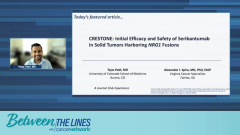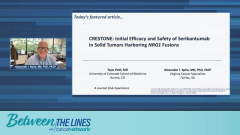
CRESTONE Trial of Seribantumab in Solid Tumors With NRG1 Fusions: Real-World Implications
Looking toward the future management of solid tumors with NRG1 fusions, expert panelists consider how the availability of seribantumab therapy may impact their practice.
Episodes in this series

Transcript:
Tejas Patil, MD: There’s one more question. If seribantumab were approved by the FDA in the future, how might its availability impact how you approach treatment of solid tumors? We briefly talked about this. I’m going to speak now in the lung [cancer] space specifically. Most of the patients here had progressed on a first-line treatment. The first-line therapy for patients with non–small cell lung cancer is some kind of platinum, pemetrexed or platinum doublet chemotherapy with immunotherapy. If this were approved by the FDA, I think this would offer a very viable option for patients who have NRG1 fusions, in the second-line setting. Certainly it’s more encouraging than the current standard, which is docetaxel. I anticipate that this would be a therapy that would be widely adopted.
The question is more broad in its reach, which is asking about the treatment of solid tumors. [In that setting] it can be an open question, but if it is approved and is available, I think there are certain tumor types where this could seriously be looked at as an option. The question that I always think about in this situation is what is the comparator in this setting? So, in the second-line setting for a solid tumor, what is the comparator? When you look at some of the tumor types that were well represented in the study, being hepatobiliary or pancreatic [tumors], it kind of makes sense to use seribantumab. Now, there were patients with breast cancer, and I think that’s where this might become a more nuanced question because breast cancer therapies, even in the second-line setting, can be very effective. What are your thoughts about that, Dr Spira?
Alexander I. Spira, MD, PhD, FACP: I think the easiest one [to consider] is lung cancer. Lung cancer is very easy because second-line therapy doesn’t work. It’s a tough drug, most people don’t like to do it, and I keep saying it would never be FDA approved in this day and age. At least that’s what I think. If you look at it against that, it’s a no-brainer. I think the tumor-agnostic [setting] is going to be a bit more challenging because you’re dealing with a lot of different tumors. We don’t have a lot of data, we have 1 pancreatic [tumor type]. Breast cancer’s tough because you can come up with 5 or 6 different breast cancer regimens that may work better than this or are easier. I think that’s where it gets a little cloudier. For me, if it was approved and you had a HER3 mutation and it was approved in a tumor-agnostic way, it’s a no-brainer. We all like this approach; we’re all dying to get our patients to targeted therapy for their mutation. Practically [speaking], if it’s approved, it’s easy, especially in lung [cancer]. I think the real question is, though it has been done on a fast-track [approval process] basis, what does that mean for the FDA? And again, I think we need a lot more data for that.
Tejas Patil, MD: We have a very encouraging waterfall plot from this presentation. But it is important to contrast that with the waterfall plot that was shown when larotrectinib presented their data for NTRK gene fusions, which was very deep and with an objective response rate that was much more dramatic than what we’re seeing here. So I think that shapes the context.
Transcript edited for clarity.
Newsletter
Stay up to date on recent advances in the multidisciplinary approach to cancer.









